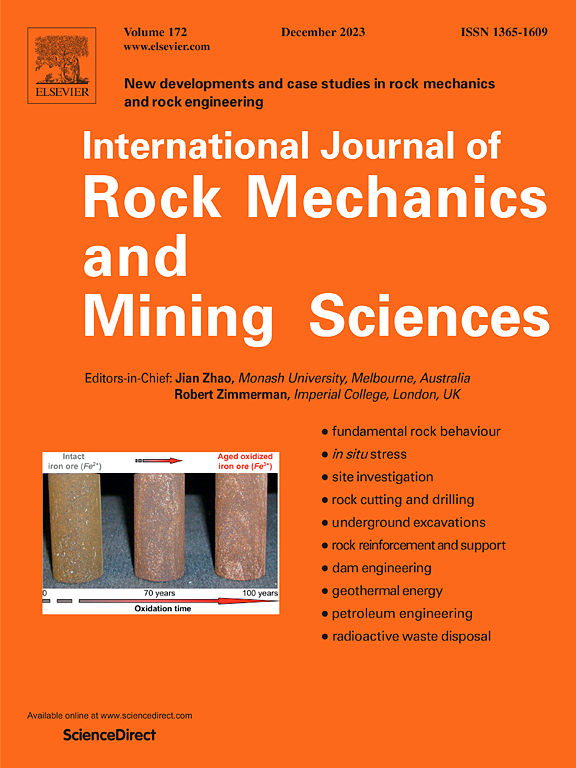爆破荷载下两条动态裂缝相互作用机理的实验研究
IF 7
1区 工程技术
Q1 ENGINEERING, GEOLOGICAL
International Journal of Rock Mechanics and Mining Sciences
Pub Date : 2024-11-15
DOI:10.1016/j.ijrmms.2024.105956
引用次数: 0
摘要
本研究进行了动态光机爆破实验,以研究不同相对位置的爆炸诱发双裂纹的相互作用机理。实验结果表明,在实验组中,当裂纹尖端开始相互作用的实际相对垂直距离在 10 毫米以内时,两条裂纹都会穿透;但当超过 10 毫米时,双裂纹最终会以相对平行的方式扩展。相对水平距离对最终断裂模式的影响较弱。当动态裂纹开始相互作用时,裂纹尖端的扩展速度和应力强度因子都会增加,裂纹扩展角度增大,裂纹扩展路径呈现弯曲特征。根据试样的最终断裂状态,裂纹尖端的相互作用结果可分为三类:无合并的挠曲、曲线合并和无合并的平行重叠。根据动态光力学实验结果和以往研究中裂纹尖端应力场的相对验证理论,提出了相互作用过程中动态裂纹尖端间应力场分布的表达式。在动态爆破引起的裂纹相互作用过程中,裂纹尖端的应力强度增加到相互作用开始时的 1.3-1.5 倍。裂纹最初相互排斥。随着裂纹尖端相对位置的增加,局部应力减弱,排斥现象也相应减弱。因此,在裂纹相互作用后,裂纹呈现出纺锤形图案。本文章由计算机程序翻译,如有差异,请以英文原文为准。
Experimental study on the interaction mechanism of two dynamic cracks under blasting loading
In this study, dynamic photomechanical blasting experiments were conducted to investigate the interaction mechanisms of dual cracks induced by explosions at different relative positions. The experimental results demonstrate that both cracks penetrate when the actual relative vertical distance at which the crack tips begin to interact is within 10 mm in the experimental group; however, when it exceeds 10 mm, the dual cracks finally expand in a relatively parallel manner. The relative horizontal distance has a weaker impact on the final fracture mode. When the dynamic cracks begin to interact, both the propagation speed of the crack tips and the stress intensity factor increase, the crack propagation angle increases, and the crack propagation path exhibits curved characteristics. Based on the final fracture states of the specimens, the interaction results of the crack tips can be classified into three categories: deflection without merging, curvilinear merging, and parallel overlapping without merging. Based on the results of dynamic photomechanical experiments and the relative verification theory of the crack-tip stress field in previous studies, an expression for the stress-field distribution between dynamic crack tips during interaction was proposed. During the interaction of dynamic blast-induced cracks, the stress intensity at crack tips increases to 1.3–1.5 times that at the onset of mutual interaction. The cracks initially repel each other. As the relative positions of the crack tips increased, the local stress weakened, and the repulsion phenomenon diminished accordingly. Consequently, after crack interaction, the cracks exhibited a spindle-shaped pattern.
求助全文
通过发布文献求助,成功后即可免费获取论文全文。
去求助
来源期刊
CiteScore
14.00
自引率
5.60%
发文量
196
审稿时长
18 weeks
期刊介绍:
The International Journal of Rock Mechanics and Mining Sciences focuses on original research, new developments, site measurements, and case studies within the fields of rock mechanics and rock engineering. Serving as an international platform, it showcases high-quality papers addressing rock mechanics and the application of its principles and techniques in mining and civil engineering projects situated on or within rock masses. These projects encompass a wide range, including slopes, open-pit mines, quarries, shafts, tunnels, caverns, underground mines, metro systems, dams, hydro-electric stations, geothermal energy, petroleum engineering, and radioactive waste disposal. The journal welcomes submissions on various topics, with particular interest in theoretical advancements, analytical and numerical methods, rock testing, site investigation, and case studies.

 求助内容:
求助内容: 应助结果提醒方式:
应助结果提醒方式:


